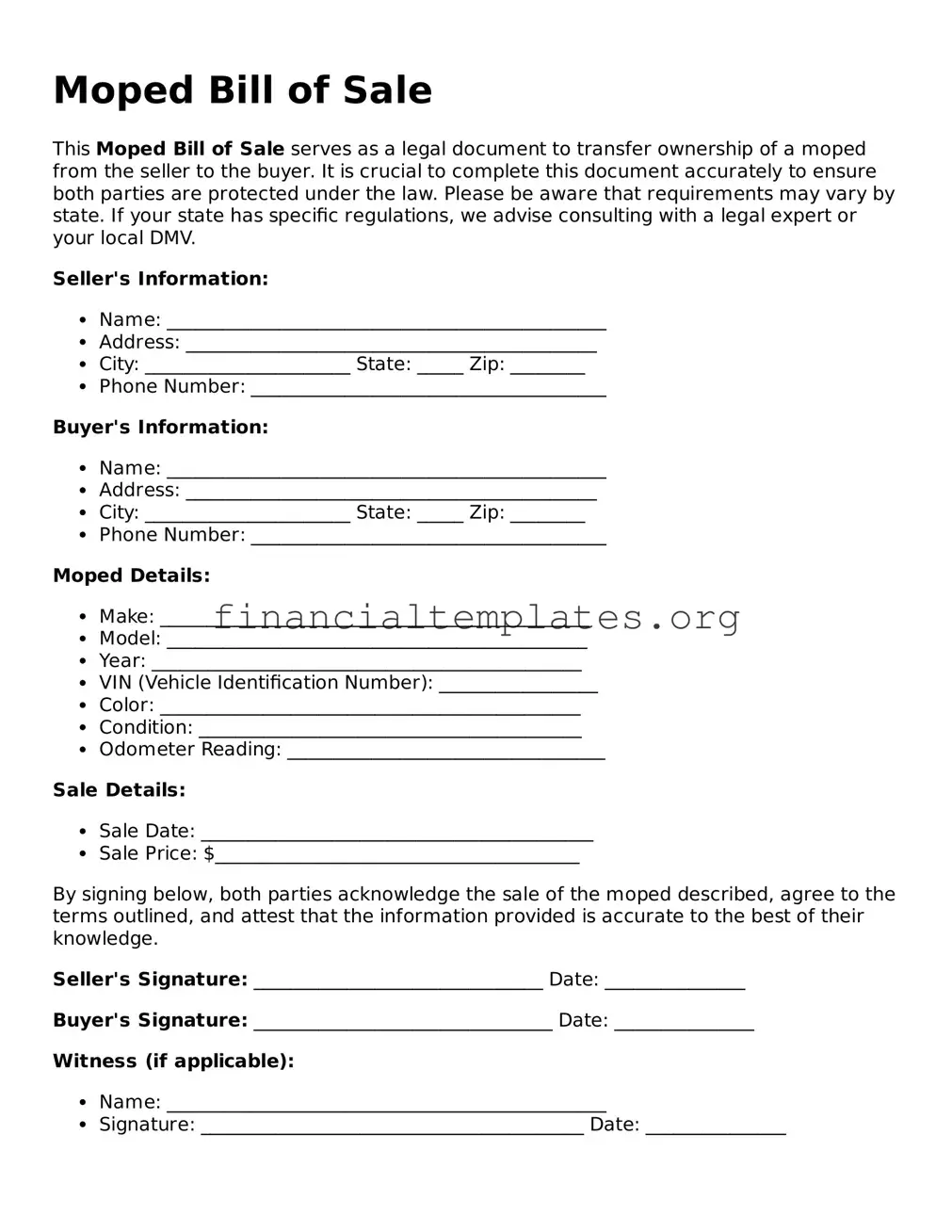The Moped Bill of Sale form shares similarities with the Vehicle Bill of Sale form. Both serve as legal evidence that a sale and purchase transaction has occurred between two parties. They detail the transfer of ownership of the item in question - a moped in one case and potentially any motor vehicle in the other. Each form typically includes information about the seller and buyer, a description of the item sold, the sale price, and the date of the sale. Both documents are crucial for the buyer's registration process of the item with the relevant authorities.
Similar to the Moped Bill of Sale, the Motorcycle Bill of Sale is another document used when conducting a sale transaction, but specifically for motorcycles. It contains key details about the transaction, including the identities of the buyer and seller, the motorcycle's details (like make, model, year, and VIN), the sale amount, and the transaction date. This document serves as proof of purchase and is often required for registration and title transfer purposes, ensuring the motorcycle's ownership is legally transferred from the seller to the buyer.
Another document akin to the Moped Bill of Sale is the Boat Bill of Sale. This document is used during the purchase or sale of a boat. It serves a similar purpose by recording the transaction details, including the buyer's and seller's information, a description of the boat, the sale price, and the date of sale. Essential for establishing legal ownership, the Boat Bill of Sale is often required by the relevant state or local agency for the registration of the boat under the new owner's name.
The General Bill of Sale is also comparable to the Moped Bill of Sale. It is a more flexible document that can be used to facilitate a wide range of personal property sales, from electronics to furniture. Like the Moped Bill of Sale, it captures the particulars of the transaction, including the details of the parties involved, a description of the item sold, the sale price, and the transaction date. This document helps provide proof of the transfer of ownership, although it may not be a formal registration requirement like it is for vehicles and boats.
The Trailer Bill of Sale is another document that shares commonalities with the Moped Bill of Sale. It is specifically used for the sale of a trailer. The form records essential details of the sale, including information about the buyer and seller, a description of the trailer (including VIN, make, model, and year), the sale price, and the sale date. It is crucial for the legal transfer of the trailer's ownership and is often required for registration and title transfer processes.
Similar to the Moped Bill of Sale, the Firearm Bill of Sale documents the sale and purchase of a firearm. It contains the names and addresses of the buyer and seller, a description of the firearm (including make, model, and serial number), the sale price, and the date of the transaction. This document is especially important due to the legal regulations surrounding firearm ownership. It serves as a record of the transfer and may be required for the registration or licensing of the firearm with local law enforcement agencies.
The Equipment Bill of Sale is akin to the Moped Bill of Sale, particularly used for the sale of heavy or specialized equipment. This document details the transaction, listing the buyer's and seller's names, a description of the equipment (including any identifying numbers or features), the sale price, and the sale date. It's a crucial document that serves as a receipt for the transaction and can be used for tax and registration purposes, depending on the type of equipment and local regulations.
Lastly, the Animal Bill of Sale is similar to the Moped Bill of Sale but is used for transactions involving animals, such as horses, dogs, or livestock. It records the sale by including information about the buyer and seller, a description of the animal (possibly including breed, color, and any registration numbers), the sale price, and the date of sale. This document is important for confirming the legal transfer of ownership of the animal and may be required for registration with breed or livestock associations.
